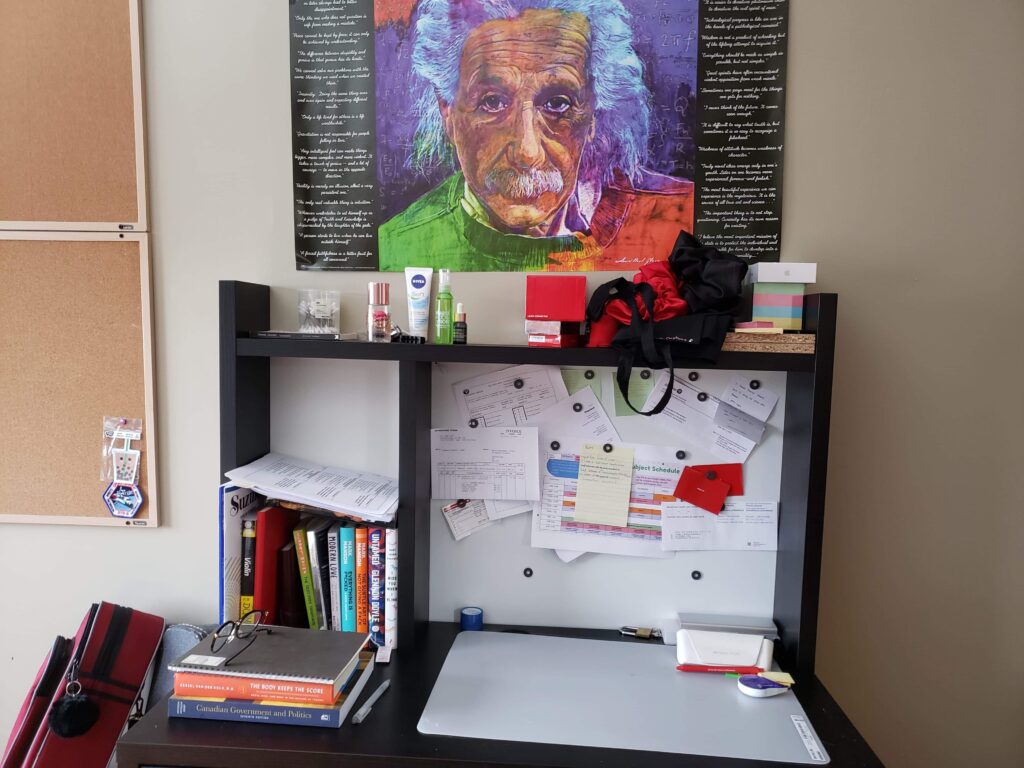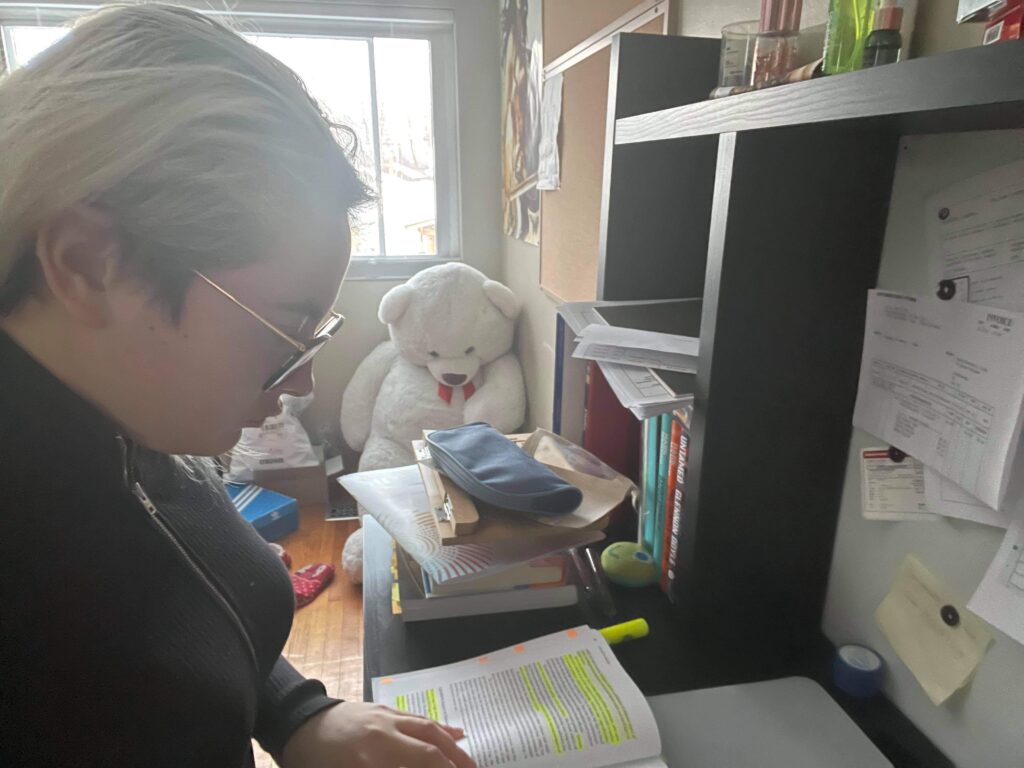When a student’s bedroom and computer turn into the classroom, it creates new challenges

The white glow of a MacBook screen shines in Isa Marin-Hernandez’s face as she starts her criminology test. Her hands are shaking, her palms are sweaty. The click of her fingers hitting the keypad is the only sound in her room. Reading the same question at least five times, she cannot shake the fact that she cannot return to this question once she submits the answer.
Time is running out and there’s another question in front of her, but Marin-Hernandez’s mind drifts back to a previous question. Was the answer A? No, it had to be C. She’d read it thoroughly. Her heart feels like it will beat right out of her chest. She’s on the verge of having a panic attack.
The anxiety that Marin-Hernandez feels is not uncommon. Transferring from the University of Toronto to Ryerson University to do a double major in criminology and politics and governance, her first semester online at Ryerson was stress-inducing. While some students prefer online learning, for others it is non-stop stressful. In a survey conducted by Core Spaces last June, 75 per cent of 2,500 student respondents said they felt more anxious and stressed with the coronavirus outbreak and campus closures. According to the survey, the top three causes of students’ stress and anxiety are uncertainty about the future of their education, falling behind in their coursework and struggling with remote learning.
Diana Brecher, a clinical psychologist who developed the ThriveRU program at Ryerson, says the causes of online anxiety vary from student to student. “Most (students) don’t associate their computer with a classroom,” Brecher says. “Most do better when they’re in a room full of people, which provides an atmosphere and sense of community that is conducive to learning.”

Isa Marin-Hernandez says she has had a tough time adjusting to studying from home.
(Photo courtesy Isa Marin-Hernandez)
That change is lost through asynchronous courses. Marin-Hernandez’s first semester of university was filled with asynchronous courses and she could not concentrate most of the time. These days, she’s still spending most waking hours at her desk. Laptop open, she presses play on the latest pre-recorded lecture. Her mind drifts after a couple of minutes and she leans back in her chair, looking up at the Albert Einstein poster above her desk. She focuses on the scientist’s green sweater as the voice of her criminology instructor echoes throughout her bedroom. She regains focus, but then her right leg starts shaking. It’s an old, anxious habit. Clicking on the play bar, she drags the icon back a couple of minutes to re-watch what she missed. She already knows she will have to watch the full lecture again. Marin-Hernandez is just like one of those students Brecher talks about: She misses being in a physical lecture. “That interactive factor was so much more useful as opposed to now, where everything is so impersonal and it feels as if everything is just in pieces,” says Marin-Hernandez.
Jenny Liu, a lecturer with the department of psychology at Ryerson, says the reason why students get anxiety from online learning is because it is happening during a pandemic, which can add a lot more pressure. “Not knowing when things will end, that kind of unknown, that uncertainty, that lack of control is a huge challenge for mental health,” she says.
She says the pandemic and associated challenges “have created shifts and adjustments to our lifestyles on an ongoing basis. Coupled with the stresses of uncertainties, socio-economic hardships, and other psychosocial stressors we may face, the resulting post-secondary education experience may be different than those that students may typically expect, such as expectations of life on residence, in-person classes, on-campus life, and getting to know fellow students and community members.”
Liu says all of these factors together, “may impact the identities and roles students may have of themselves, their interactions and ways of receiving support from their fellow peers, professors, and community members, and impact the ways in which students experience their post-secondary education.”
There is also huge anxiety associated with having webcams on during a lecture. Mark Antczak, an in-house registered clinical counsellor and clinical educator at Anxiety Canada, says this could possibly be because of students’ fear of judgment. “On Zoom, there are probably some who are worried about what other students might be thinking, either based on what is in their background or the way they appear on the screen,” he says.
Sarah Hsiung knows this first-hand. Hsiung, a first-year student at Western University, says her English tutorial gives her a lot of stress and that her instructor prefers students to have their cameras on. “I don’t like that, because then I feel like I can’t freely share my ideas,” she says. “I feel like they are judging me no matter what.”
Brecher says there are many ways to alleviate students’ anxiety associated with online learning, including her recommendation that students should move around when they are online. “Anxiety is also in the body, so if you can relax the body, either through speeding up an exercise or slowing down through meditation, you can manage the symptoms of anxiety,” she says.
Brecher also notes that anxiety generally comes from people thinking about the worst possible scenario. To alleviate this, she recommends the Worst Case/Best Case exercise. “We can do this by first imagining the worst-case scenario and then assign a percentage of how likely this will actually happen,” says Brecher. “Then, imagine the best-case scenario and assign a percentage to how likely it will happen. Finally, considering the above scenarios and how unlikely either will happen — then imagine the most likely scenario and assign a percentage to that. Follow up with an action plan.” This exercise can be found in Thriving in Action Online, a website developed by Brecher and Deena Kara Shaffer in 2019.
Hsiung’s anxiety relief comes from the support of her mom. “My anxiety blinds me from the fact that I need to take care of myself. So she’s always there reminding me that.”
When Marin-Hernandez feels the dreadful wave of anxiety taking over, she reaches for a beanbag of Mike Wazowski, a character from the film Monsters, Inc. Tossing the small bean bag back and forth between her hands, her anxiety calms down and she finds her mind and body relaxing.
With a one-eyed green monster to help her through the worst of her anxiety, she’s prepared to do what’s needed. She knows the shift back to in-person classes will take some time to get used to. But it will be worth it.
“It’s kind of like getting up from a chair that you’ve been sitting in for hours, where everything is asleep,” she says. “But at the same time you know you have to slowly reawaken yourself.”
Yasmeen Aslam
This article may have been created with the use of AI tools such as
